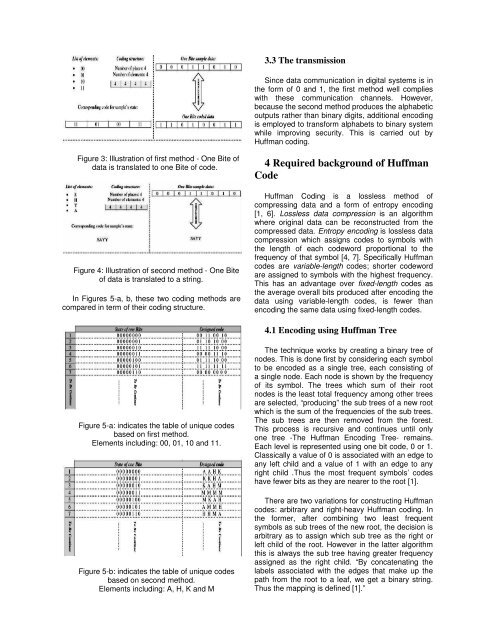Data Encryption Based On Protein Synthesis - Nguyen Dang Binh
Data Encryption Based On Protein Synthesis - Nguyen Dang Binh
Data Encryption Based On Protein Synthesis - Nguyen Dang Binh
Create successful ePaper yourself
Turn your PDF publications into a flip-book with our unique Google optimized e-Paper software.
Figure 3: Illustration of first method - <strong>On</strong>e Bite of<br />
data is translated to one Bite of code.<br />
Figure 4: Illustration of second method - <strong>On</strong>e Bite<br />
of data is translated to a string.<br />
In Figures 5-a, b, these two coding methods are<br />
compared in term of their coding structure.<br />
Figure 5-a: indicates the table of unique codes<br />
based on first method.<br />
Elements including: 00, 01, 10 and 11.<br />
Figure 5-b: indicates the table of unique codes<br />
based on second method.<br />
Elements including: A, H, K and M<br />
3.3 The transmission<br />
Since data communication in digital systems is in<br />
the form of 0 and 1, the first method well complies<br />
with these communication channels. However,<br />
because the second method produces the alphabetic<br />
outputs rather than binary digits, additional encoding<br />
is employed to transform alphabets to binary system<br />
while improving security. This is carried out by<br />
Huffman coding.<br />
4 Required background of Huffman<br />
Code<br />
Huffman Coding is a lossless method of<br />
compressing data and a form of entropy encoding<br />
[1, 6]. Lossless data compression is an algorithm<br />
where original data can be reconstructed from the<br />
compressed data. Entropy encoding is lossless data<br />
compression which assigns codes to symbols with<br />
the length of each codeword proportional to the<br />
frequency of that symbol [4, 7]. Specifically Huffman<br />
codes are variable-length codes; shorter codeword<br />
are assigned to symbols with the highest frequency.<br />
This has an advantage over fixed-length codes as<br />
the average overall bits produced after encoding the<br />
data using variable-length codes, is fewer than<br />
encoding the same data using fixed-length codes.<br />
4.1 Encoding using Huffman Tree<br />
The technique works by creating a binary tree of<br />
nodes. This is done first by considering each symbol<br />
to be encoded as a single tree, each consisting of<br />
a single node. Each node is shown by the frequency<br />
of its symbol. The trees which sum of their root<br />
nodes is the least total frequency among other trees<br />
are selected, “producing” the sub trees of a new root<br />
which is the sum of the frequencies of the sub trees.<br />
The sub trees are then removed from the forest.<br />
This process is recursive and continues until only<br />
one tree -The Huffman Encoding Tree- remains.<br />
Each level is represented using one bit code, 0 or 1.<br />
Classically a value of 0 is associated with an edge to<br />
any left child and a value of 1 with an edge to any<br />
right child .Thus the most frequent symbols’ codes<br />
have fewer bits as they are nearer to the root [1].<br />
There are two variations for constructing Huffman<br />
codes: arbitrary and right-heavy Huffman coding. In<br />
the former, after combining two least frequent<br />
symbols as sub trees of the new root, the decision is<br />
arbitrary as to assign which sub tree as the right or<br />
left child of the root. However in the latter algorithm<br />
this is always the sub tree having greater frequency<br />
assigned as the right child. “By concatenating the<br />
labels associated with the edges that make up the<br />
path from the root to a leaf, we get a binary string.<br />
Thus the mapping is defined [1].”
















